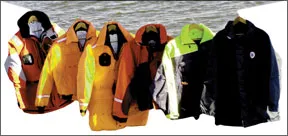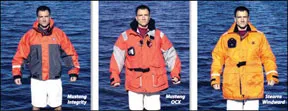When you go overboard without meaning to, your world is almost literally turned upside down. Even in the best conditions, you’ll quickly want as much protection as possible, particularly if rescue isn’t imminent. Float coats provide the flotation you need to keep from drowning in all but the most extreme situations, and some offer defense against hypothermia, a real danger in many locations around the globe.
What We Tested

288
Practical Sailor gathered six models that represent the broad spectrum of float coat products available. We procured products from Stearns Inc., Mustang Survival, and FloatTech. Two of the models we tested are inflatable, the rest rely upon foam for their buoyancy, and one product is available with an integral harness. All are U.S. Coast Guard approved as Type III flotation aids, except the inflatable by Mustang Survival, which is approved as a Type V. All come with an owner’s manual (definitely recommended reading).
This collection of products offers a range of features. Thus, this is not entirely an apples-to-apples comparison. There are a few oranges in this group, and maybe even a pomegranate. We should also mention that we’re aware of two other companies that make such float coats Stormy Seas and Guy Cotten but we were unable to obtain their products in time for testing. Look for a future update on those.

288
Foam Jackets
If the sailing you do takes place most often in cold waters say, anything 70 degrees or colder hypothermia is a very serious concern. If worn properly, the garments containing foam insulation will offer better protection from the cold water than the inflatable garments. However, foam offers less buoyancy than inflatable bladders and is less likely to right an unconscious man overboard. But, of course, you can always wear a foam jacket underneath a traditional inflatable PFD for dual buoyancy.
Stearns Powerboat Jacket
This waist-length jacket has a water-resistant (coated nylon) outer shell with closed-cell, polyvinyl chloride foam (¾ inch in the torso, ¼ inch in the sleeves) sewn inside a nylon inner liner.
Stearns uses a product called Suisse Aire foam, which its literature describes as “soft and supple.” There is foam in the 5-inch collar, but Type III products are not required to support the wearer’s head.
The bright orange model we tested (the jacket is offered in five colors) features ¾-inch SOLAS reflective strips sewn around the lower forearm, across the upper back, and across the collarbone region. This offers decent visibility at night, but we’d prefer wider strips to enhance that visibility. An optional hood (($40, with or without insulation) can be attached to the jacket via snaps on the fleece-lined collar, but the Stearns hoods lack reflective tape. Often the only visible part of a man-overboard is the head, so we’d like to see reflective material on the hood.
This jacket closes by way of a large YKK Vislon zipper and a Velcro flap. The zipper is easy to use even with cold or gloved hands. There’s also a strand of 1-inch nylon webbing that loops around inside the jacket waist and is fitted with an adjustable, hard-plastic snap buckle to keep the jacket from riding up while the wearer is in the water. The jacket has ample storage space: five outer pockets (including three sealable cargo pockets with drain holes), and one inner pocket large enough to accommodate a handheld VHF. The inner liner has a 1-inch strip of mesh sewn along the jacket bottom that allows water to exit and the foam between the inner and outer layers of fabric to breathe when the garment is stored.
Our testers were less than enthusiastic about the knitted elastic material in the cuffs and the coat’s waistband. This knitted material appears insubstantial, and not apt to hold its elasticity over time. We’ll see what longterm testing turns up.
The jacket was comfortable on shore, but received a Good rating for comfort in the water because one tester found it slightly uncomfortable around the neck. On the plus side, the Powerboat Jacket has one of the best adjustable waist belts among the garments we evaluated, and our testers liked that it drains faster than the others when the victim is pulled out of the water. The initial retention of water in a float coat is enough to make these garments heavy when a victim is pulled from the water.
Mustang Integrity Jacket
The shell of this waist-length jacket is made from water-resistant nylon, both ripstop and non-ripstop. For insulation and buoyancy, Mustang Survival utilizes a proprietary product it has trademarked as AirSoft foam, a PVC, closed-cell foam.
The front of this two-tone jacket (it comes in charcoal/black, red/charcoal, orange/charcoal, and yellow/charcoal) opens with a large, urethane-coated YKK zipper protected by a 3-inch flap of reinforced nylon that seals over the zipper with intermittent Velcro-type closures. The wrists have an adjustable Velcro strap to keep warmth in and moisture out. Each sleeve has 7½ inches of 1-inch Scotchlite reflective material on the forearm. Save for an 8-square-inch patch on the tuck-away hood, this is the only reflective material on the coat. We’d prefer to see some on the shoulders because it’s entirely possible that a victim in the water with this jacket on might not even remember to utilize the hood.
Due to the cut of the jacket’s nylon panels, it felt more form-fitting, in our opinion, and therefore more comfortable out of the water than the Stearns Powerboat Jacket. This jacket was plenty comfortable in the water, but it lacks the waist-cinching belt other test garments have. The Integrity Jacket has a wide elastic section at the back of the waist and a short, cinchable nylon strap on each side of the waist, which Mustang says offers “two-way volume adjustment.” These straps don’t offer the broad range of adjustment that the full belts do. That said, the Integrity did not ride up when worn in the water.
Mustang claims that the Integrity Jacket has at least 17 pounds of buoyancy (testing confirmed this), which the garment achieves with six foam panels. Those in the front of the jacket are ¾-inch thick. The back is ¼-inch thick, and the panels in the sleeves and the collar are 1/8-inch thick. The fleece-lined collar houses a detachable hood, which has a cinchable centerline adjustment strap. There are three outer pockets that zip closed, and one inner breast pocket that closes by way of a Velcro patch. Under each arm, near the armpit, 5-inch zippered vents allow enhanced air circulation through a mesh fabric.
Mold/mildew testing yielded small stains on the jacket’s white label, but none on the nylon.
Mustang also offers the Integrity in a mid-thigh-length coat.
Bottom Line: Among the foam-filled jackets, it’s hard not to like Mustang Survival’s Integrity. It offered nearly equal performance in the buoyancy portion of our test relative to Stearns’ Powerboat Jacket, but the Integrity has the edge in comfort. And certainly this product has more bells and whistles than the Stearns Powerboat Jacket. Features like adjustable cuffs and an adjustable hood with SOLAS reflective tape are important in our view, but do they justify the additional $100 on the price tag? Considering that adding a comparable hood to the Stearns product accounts for 40 percent of the price differential, the additional cost seems somewhat more palatable.

288
If you’re going to wear one of these jackets on shore and on the boat, you’re better off with the Integrity. But if you’re going to wear it exclusively on the boat, we recommend the Powerboat Jacket. It is more visible and less expensive.
Foam Coats
These have all the perks of foam jackets, plus the coats’ longer length (upper to mid thigh) allows the wearer to keep a dry backside without having to wear splash pants in a wet cockpit. The downside of the coat’s skirt (that part of the coat beneath the waist belt) is that it often floats up when the wearer is in the water, reducing the coat’s protection and warmth.
Stearns Windward Jacket
The Stearns Windward Jacket is similar in construction and materials to the Powerboat Jacket, but it extends to the mid thigh. Available in three colors, this garment has the same distribution of SOLAS reflective tape and the same mesh drainage strip as the Powerboat Jacket.
The collar has a soft, fleece lining (as do two of the front pockets), and it unzips for access to an adjustable, nylon hood with two 6-inch strips of SOLAS reflective tape. The Windward Jacket has adjustable Velcro cinch straps on each wrist, and a 2-inch, adjustable, nylon waist belt housed in a dedicated sleeve outside the jacket. The wrist cuffs are made of the same material as those on the Powerboat Jacket, but they’re recessed into the sleeve for protection. There are five outer pockets (the three cargo pockets have drain holes), one inner pocket (large enough for a handheld VHF), and an external, neoprene pouch sewn on to the breast for stowing a personal strobe light.

288
Stearns Inc. claims the Windward has “waterproof construction,” which means the outer shell and seams won’t allow water to intrude. PS tested both shoulder and arm seams, and we didn’t detect any leaks. After a week lying wet in a plastic bag, the Windward had some stains on the nylon from grommets, but it did not have mold or mildew.
The coat, offered in three colors, closes with a full length, two-way, plastic zipper. The zipper is protected by a 2½-inch flap of the same outer fabric that seals the entire length with a Velcro closure.
This coat was comfortable in and out of the water. When worn as a PFD, it enabled each tester to keep his mouth well above the water’s surface. The one problem testers experienced was that the skirt tends to invert and float up too easily. This won’t affect the product’s buoyancy, but it will allow warmth to escape from the wearer if that person is in the water for a long time.
Mustang Classic Coat
Mustang’s Classic Coat (MC 1504) is built with a water-resistant nylon shell over a ½-inch of closed-cell AirSoft foam in the front, ¼-inch in the back, and 1/8-inch in the sleeves. There is also foam in the collar.
The mid-thigh-length coat comes in red, orange, and navy, and has only two zippered pockets. With a coat this length, one might expect to find a two-way zipper, but it closes with a large, full-length single YKK zipper protected by a 2-inch Velcro flap.
The Classic Coat does not come with a hood, but Mustang makes several snap-on hoods that will fit it. The coat does have an adjustable external waist belt. This model has long been used by U.S. military forces.
Though it’s comfortable in the water, the Classic Coat totally lacks one feature testers consider imperative for this kind of safety product: reflective material. As with Stearns’ Windward Jacket, the skirt on this coat tends to invert and float up in the water. The Classic’s sleeve ends aren’t adjustable or cinchable. Instead, the woven elastic cuffs are recessed into the sleeves like those on the Windward.
Like the Mustang Integrity, the Classic had mildew stains only on its label, but not on the jacket.
Bottom Line: Among the foam-filled mid-length coats, we give the edge to Stearns’ Windward Jacket. This product and Mustang’s Classic Coat were equal in terms of comfort, and almost identical in the actual measured buoyancy they offer. However, the Stearns coat has several features not found on the Classic, including adjustable wrist cuffs, a dedicated strobe light pocket, a two-way zipper, and an integral hood. It’s also $50 less than the Classic. Slam dunk.
Inflatable Coats
The first objective of float coats is to provide flotation, and in that regard, those with inflatable bladders have the upper hand. The inflatable products we tested are designed to roll an unconscious person over in the water, and both will put the wearer’s mouth slightly higher above the water’s surface than foam coats.
FloatTech
The FloatTech, which Practical Sailor initially reviewed in the Nov. 1, 2005 issue, is a Type V device, USCG-approved as a Type III PFD, but that is only when the coat is worn and the inflatable mechanism is armed. The product is actually three items in one—an inflatable PFD zipped into a light multi-weather coat that has detachable sleeves (via zipper) so that it can also be worn as a vest.
The PFD can be set for manual or automatic inflation and comes with a tube for oral inflation. It uses a Halkey-Roberts V90000 auto-inflation mechanism. The company recommends that you inspect the product every two months and have it serviced by a certified representative once every two years.
Because its sleeves zip off, the FloatTech is more suitable for use in warm weather than the other products we tested. It comes in several color combinations, and features four external pockets. It also has a tear-away Velcro flap on the right breast so that the user can easily inspect the status of the auto-inflation device. It uses a full-length, two-way YKK zipper protected by a 3¼-inch Velcro flap. An adjustable bungee cord is sewn into the bottom of the jacket so that it can be snugged to keep out the wind and moisture. The 5-inch collar has a full-length, ¾-inch strip of 3M Scotchlite reflective material, and the spray hood that stows inside the collar also has a small bead of the same material around its periphery for a combined total of 30 square inches of reflective material.
The wearer must don the coat and then clip together the two plastic, quick-release buckles that fasten the PFD vest before zipping up the coat. The garment has gussets under the arms and in the chest that allow it to expand when the PFD inflates.

288
The FloatTech allows for a safety harness to be worn underneath it, and it has two small, zippered openings on either side of the main zipper for access to the harness D-rings or O-rings (see photo above). One problem testers found with these openings is that because there is no inner layer, water can get inside the jacket through the openings, even with the harness deployed.
Sailors who are accustomed to donning their safety harnesses over a foul-weather jacket take note: The harness goes beneath the FloatTech because this garment’s inflatable chambers can cause harm to the user if they’re restricted by anything worn outside the coat. Cecilia Domingos, a co-founder of FloatTech and the company’s CEO, told us that the Crewsaver Sovereign harness and the West Marine Basic and Ultimate harnesses fit the coat’s openings. It also works with most single and double D-ring harnesses of similar design.
The coat’s bladder is three pillow-shaped chambers two on either side of the chest area and one across the back, near the shoulders. When inflated, these chambers keep the wearer in an upright position in the water.
The FloatTech coat restricted the testers’ movement slightly due to the extremely taut inflation of the chambers. However, the only real downside was that, when inflated, the coat rode up on one tester while in the water and rubbed noticeably beneath his armpits. Domingos explained later that our tester likely had the wrong size, or the buckles weren’t adjusted tightly enough.
Mustang OCX Jacket
The Mustang OCX Offshore Racing Jacket with Harness is a serious product that carries a serious price: $750. It’s a full-featured offshore foul-weather jacket with a built-in automatic-inflation system that the manufacturer claims will afford the user 40 pounds of buoyancy. Our measurements confirmed this.

288
The OCX Jacket (Ocean Class Extreme), which is advertised as “waterproof” and “breathable,” is approved by the USCG as a Type V flotation aid only when its inflatable element is armed. Mustang Survival claims that its performance is equivalent to Type III devices.
The OCX Jacket uses a single inflatable bladder laid out in a proprietary, trademarked system that Mustang Survival calls LIFT (Life-saving Inflatable Flotation Technology). This chamber has large sections in the front, encircling the underarms, and leading to a smaller section in the back. The bladder can be snapped out, but Mustang Survival highly recommends buyers do not do this as it is difficult to get back in the jacket and its removal could mean it would no longer qualify as a Coast Guard-approved PFD, a company official said.
The OCX Jacket comes with an integrated safety harness or without. It’s available in two colors. PS tested the model with the harness. It’s important for users to understand in advance the dangers inherent in using an inflatable device and a harness at the same time. Mustang’s product literature clearly points out that the OCX must be worn properly with the harness adjusted to fit prior to inflation. Also, the wearer must be at least 5 feet, 5 inches tall. The harness’ stainless steel rings are accessed via small, zippered openings on either side of the main zipper. Fashioned from stout, 3-inch nylon webbing, the harness can be adjusted via the storm flaps. Unlike the FloatTech, the OCX has an inner layer that prevents water from getting to the wearer through the harness D-ring holes.

288
The outside shell is made of Gore-Tex. The garment stops just below the waist. The lower portion of the jacket’s back has a layer of rugged, textured Kevlar that will both protect the garment from wear and tear and enable the wearer to attain nonskid-like traction when seated. The wrist cuffs seal more securely than any other product we tested because they have adjustable neoprene-like inner cuffs, as well as adjustable Velcro flaps sewn on the outside. Also, there is an adjustable 1½-inch nylon waist belt that clips together on the outer jacket front by way of a plastic quick-release buckle. Foam pads sewn inside the sleeves help cushion the elbows and enhance buoyancy.
The OCX jacket has five outside pockets (two lined with fleece, two with Velcro flaps, and one on the shoulder with a zipper), and one inside pocket sizeable enough for a handheld VHF. There are two 9- inch x 2-inch strips of reflective tape on the shoulders, and the stowable hood also has a 4½-inch x 2-inch strip of SOLAS reflective tape sewn to it. The hood, which tucks conveniently into the 7-inch, fleece-lined collar, is dayglow green and includes a protective, fleece-lined face flap that also tucks into an pocket. The hood also has a centerline Velcro buckle for adjustment, plus elastic cinch lines and clips on either side. It’s the most advanced hood among all the products we tested.
In the breast of the jacket, there’s a vinyl inspection window for checking the auto-inflating device, a Halkey Roberts Pro 1F. The coat can also be set to manually inflate, and it has an oral inflation tube. Mustang recommends leak testing the device every three months, and performing a comprehensive inspection once a year.
The OCX was comfortable in and out of the water, but once inflated, the coat restricted the wearer’s neck movement. Still, it was slightly easier to swim with it inflated than in the inflated FloatTech. Both essentially limited the wearer to an awkward, upright version of the breast stroke.
Mold/mildew testing left the OCX with a musty smell, but not so bad as to earn it less than a Good rating in this test category.
Bottom Line: Determining a winner between the two inflatable jackets is complicated. Both coats performed as advertised and both easily kept each tester’s mouth well above the water, though Mustang’s OCX has a slight edge in this department.
For out-of-the-water comfort, the jackets are even, but the OCX clearly will keep you warmer due to its heavier outer fabric and non-zip-out sleeves. And it will keep you dryer since it doesn’t allow water to creep in through the harness accesses.
In the water, the FloatTech was less comfortable due to the taut inflation of the bladder and its less ergonomic design.
We also prefer the OCX’s features, particularly the added visibility and protection afforded by its hood, its double-cinch cuffs, its more liberal use of reflective material, and the heavier outer shell. But, do those factors outweigh a price difference of more than $500?
It depends on your needs. Professional racers and high-lattitude sailors may find it worth the extra ducats, but for the average sailor, we figure that if you go into the drink, the FloatTech can save your life just as well as the OCX. You’ll just be slightly less comfortable until rescuers arrive.
Conclusions
After testers weighed the pros and cons of foam versus inflatable flotation, and considered each jacket’s features, prices, and performance, they tapped the Mustang Integrity as the overall Best Choice. It is the favorite of the foam-flotation garments tested, and it offers more protection from cold weather than the windbreaker-style inflatable jackets.
However, if you find yourself sailing mostly in the lower latitudes and needing a lighter-weight float coat, we suggest the FloatTech.
We also recommend the mid-thigh-length Stearns Windward and the Budget Buy Stearns Powerboat.
FLOATECH, 518/266-0964
floattech.com
MUSTANG, 360/676-1782
mustangsurvival.com
STEARNS, 800/333-1179
stearnsinc.com






































